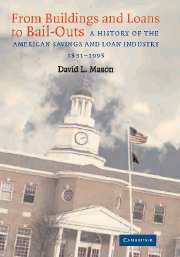 From Buildings and Loans to Bail-Outs
From Buildings and Loans to Bail-Outs Book contents
- Frontmatter
- Contents
- List of Tables
- Acknowledgments
- Introduction
- 1 A Movement Takes Shape, 1831–1899
- 2 The Rise of the League, 1900–1929
- 3 From State to Federal Oversight
- 4 The Movement Becomes an Industry, 1930–1945
- 5 The Glory Years, 1946–1955
- 6 External Challenges and Internal Divisions, 1956–1966
- 7 Lost Opportunities, 1967–1979
- 8 Deregulation and Disaster, 1979–1988
- 9 Resolving the Crisis, Restoring the Confidence, 1989–1995
- 10 The American Savings and Loan Industry in Perspective
- Appendices
- Bibliography
- Index
9 - Resolving the Crisis, Restoring the Confidence, 1989–1995
Published online by Cambridge University Press: 29 October 2009
- Frontmatter
- Contents
- List of Tables
- Acknowledgments
- Introduction
- 1 A Movement Takes Shape, 1831–1899
- 2 The Rise of the League, 1900–1929
- 3 From State to Federal Oversight
- 4 The Movement Becomes an Industry, 1930–1945
- 5 The Glory Years, 1946–1955
- 6 External Challenges and Internal Divisions, 1956–1966
- 7 Lost Opportunities, 1967–1979
- 8 Deregulation and Disaster, 1979–1988
- 9 Resolving the Crisis, Restoring the Confidence, 1989–1995
- 10 The American Savings and Loan Industry in Perspective
- Appendices
- Bibliography
- Index
Summary
By the end of 1988, it was clear to most policy makers that the initial efforts to contain the S&L crisis were inadequate and that unprecedented measures were needed to bring the debacle to an end. With hundreds of insolvent thrifts losing millions each week and public indignation growing, Congress took the first step in the recovery process when it passed the Financial Institution Reform, Recovery and Enforcement Act of 1989. This landmark legislation created the Resolution Trust Corporation, which operated through 1995 and disposed of billions in failed thrift assets. More importantly, the law also overhauled the thrift regulatory structure and began the process of industry re-regulation. By the early 1990s, what remained of the sector was working to restore public confidence. One element of this process involved emphasizing how thrifts were community organizations committed to serving local financial needs by offering an array of consumer products and services. Significantly, this approach was strikingly similar to the messages used to promote the industry in the late nineteenth century. Another concern in the wake of the thrift debacle was identifying how and why it had happened. Given the scale and scope of the crisis, there was no one overarching explanation, but rather it resulted from a combination of factors, of which ill-advised lending decisions and lax oversight were the most important. Significantly, fraud was not a major cause of thrift failures despite its prominence in several high-profile insolvencies.
- Type
- Chapter
- Information
- From Buildings and Loans to Bail-OutsA History of the American Savings and Loan Industry, 1831–1995, pp. 241 - 265Publisher: Cambridge University PressPrint publication year: 2004


